In today’s fast-paced business environment, organizations must prioritize Human Resources (HR) compliance to foster a healthy workplace and avoid costly legal pitfalls. HR compliance involves adhering to laws and regulations that govern the employer-employee relationship, encompassing a broad range of aspects, from workplace safety to employee rights. In this blog, we will explore the significance of HR compliance, the key regulations to be aware of, and practical steps businesses can take to ensure they stay on the right side of the law.
Understanding HR Compliance
At its core, HR compliance is about ensuring that a company adheres to applicable laws and standards related to employment. These can include federal, state, and even local regulations. Non-compliance can lead to legal repercussions, financial penalties, and irreparable damage to an organization’s reputation. Therefore, having a robust HR compliance framework isn’t just a legal formality; it is essential for fostering trust, promoting a positive company culture, and enhancing employee morale.
Key Regulations to Keep in Mind
1. Fair Labor Standards Act (FLSA): This act sets the minimum wage, overtime pay eligibility, recordkeeping, and youth employment in the United States. Ensuring compliance with FLSA prevents wage disputes and helps establish fair pay practices.
2. Occupational Safety and Health Administration (OSHA): OSHA requires employers to provide a safe working environment for employees. Regular safety audits and training can help organizations meet these standards and reduce the risk of workplace accidents.
3. Americans with Disabilities Act (ADA): The ADA prohibits discrimination based on disability and mandates reasonable accommodations for employees. Familiarity with the ADA not only helps organizations comply legally but also promotes inclusivity and diversity.
4. Family and Medical Leave Act (FMLA): This act entitles eligible employees to take unpaid, job-protected leave for specified family and medical reasons. Knowing how to navigate FMLA compliance is crucial for maintaining employee trust and satisfaction.
5. Equal Employment Opportunity (EEO) Laws: These laws ensure that hiring practices are fair and based on merit, not discrimination. HR must regularly review recruitment practices to ensure adherence to EEO principles.
Practical Steps for HR Compliance
1. Regular Training and Education: Conducting regular training sessions is vital for keeping employees informed about workplace rules and regulations. This can include workshops on anti-discrimination practices, safety protocols, and sexual harassment prevention.
2. Develop Clear Policies: Having well-defined employee handbooks and policies that outline company expectations is essential. Policies should cover employee rights, disciplinary procedures, and benefits. Ensure that these documents are easily accessible and regularly updated to reflect current laws.
3. Conduct Regular Audits: Routine compliance audits can help identify potential areas of non-compliance before they escalate into serious issues. Analyzing hiring practices, pay structures, and employee feedback can provide valuable insights.
4. Consult Legal Experts: Engaging with legal professionals who specialize in employment law can help organizations navigate complex regulations and ensure compliance. They can also assist in drafting policies that align with legal standards.
5. Encourage Open Communication: Create a culture where employees feel comfortable reporting concerns. An open-door policy can promote transparency and make employees more likely to voice issues before they escalate.
In a continually evolving legal landscape, HR compliance remains a pivotal aspect of successful business operations. By understanding key regulations and implementing strategic practices, organizations can foster a compliant, fair, and supportive workplace. Remember, prioritizing HR compliance is not just about avoiding penalties; it is about cultivating an environment where employees thrive, and businesses flourish. A commitment to compliance today lays the foundation for a stable and prosperous tomorrow.






